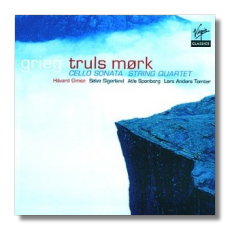
The Internet's Premier Classical Music Source
Related Links
- Grieg Reviews
- Latest Reviews
- More Reviews
-
By Composer
-
Collections
DVD & Blu-ray
Books
Concert Reviews
Articles/Interviews
Software
Audio
Search Amazon
Recommended Links
Site News
 CD Review
CD Review
Edvard Grieg

- Cello Sonata in A minor, Op. 36
- String Quartet in G minor, Op. 27
Truls Mørk, cello
Håvard Gimse, piano
Sølve Sigerland, violin
Atle Sponberg, violin
Lars Anders Tomter, viola
Virgin Classics 5 45505 2 DDD 62:16
Edvard Grieg presents a paradox: he is a beloved composer whose fame rests on just a couple of works. Everyone knows the Peer Gynt suites, of course, and the Piano Concerto, and piano students have tackled the Lyric Pieces, but beyond those works, Grieg is not as well known as one might expect.
Even long-time classical music aficionados can be thrown off guard. I don't think I'd ever heard the Cello Sonata before. Nevertheless, I'd call it a major work, one cut very much from the same cloth as the String Quartet also presented here. The first movement is wild, like a storm front rushing down a Norwegian fjord. The second movement offers reminiscences of Grieg's incidental music from the play Sigurd Jorsalfar – another one of those tunes that most people can recognize but few can identify. The finale takes on almost orchestral proportions, demonstrating the composer's wish to be associated with more than folk music and cute miniatures. Grieg wrote this sonata for his cellist brother, but it was a different cellist, Friedrich Grützmacher, who gave this work its public première.
The more familiar String Quartet also opens with a healthy dose of Sturm und Drang. The slow movement is elegiac, but with troubled episodes, and the succeeding Intermezzo recalls Dvořák, albeit with a Norwegian accent. The Finale, with its insistent triplets, is marked "Presto al Saltarello" after the Italian dance. Grieg never lets the tension sag, and this Quartet, while lacking relaxed joie de vivre, is a life-giving experience, despite the preponderance of minor keys.
Mørk and Gimse (playing Grieg's own piano) recorded the Sonata in Grieg's own house, Troldhaugen. (It's also the Edvard Grieg museum.) Mørk's buzzy tone and energetic bowing arm are just right for the sonata, but Gimse has to work hard not to fade into the background. (The timbre of Grieg's piano is a contributing factor here.) For the String Quartet, Mørk, moving to another venue, is joined by three other musicians. Virgin doesn't say whether this is an ad hoc ensemble, or simply one without a name. Nevertheless, their performance is a solid one, and it ranks with the best, even if other ensembles (the Guarneris, for example) dig in more. The important thing is that there is no self-conscious beautification of tone or sweetening of the interpretation from these Norwegian players. The engineering is forward and exciting.
Copyright © 2002, Raymond Tuttle


















